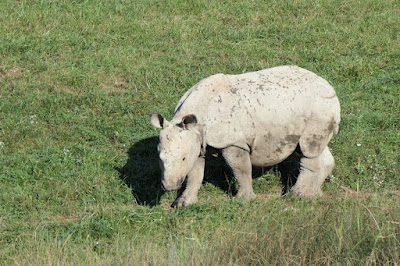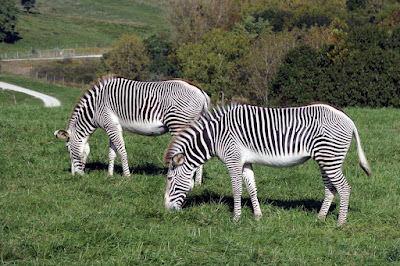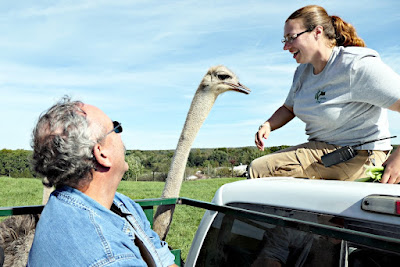My apologies for the delayed publication of this post.
On October 1st Joan and I participated in the "Fall Safari" at The Wilds, a private, non-profit conservation center associated with the Columbus Zoo and Aquarium. It's located on nearly 10,000 acres of reclaimed strip mine land in rural southeastern Ohio. This was a progressive tour with multiple stops and dinner.
All the participants gathered in the early afternoon at the Overlook Cafe for registration, and then we set out in open-air buses. The first stop was at the Outpost, a viewing facility in the middle of the pastures. (You can even spend the night there.) Southern white rhinos, an African species, visited us here, lured by food and curiosity. They are grazers, with pendulous heads and poor eyesight, but a great sense of smell.
 |
This is a large one!
|
Youngsters were here too. The Wilds has developed an immensely successful breeding program, having the space to allow the rhinos to feed naturally and form social groups.
 |
Click on any image to enlarge.
|
Even with their thick hides, the rhinos enjoy a good scratch.Females weigh up to 3750 lbs., and males up to 5070 lbs. Their feet must support the load.
Only a few rhinos are allowed into the viewing area at a time, but they can still meet with their friends over the fence.Then we reboarded our buses. Joan and I were lucky to be on the one hosted by Dan Beetem, Director of Animal Management at the Wilds. He was both knowledgeable and had a bagful of stories to tell.
The takins are one of our favorites here, a unique, rambunctious creature of the Himalayas. Our photo opportunities were not well positioned, but I felt obligated to shoot anyway.
Hi there!
This bison (the Wilds has an entire herd) was sporting a headdress of greenery.Our next stop was at the Carnivore Center, where our first encounter was with African wild dogs. The meal for these pack hunters was being thrown into their compound.Cheetahs are among the most beautiful of mammals, lithe and capable of running at up to 60 miles per hour. Beginning a decade ago, they were another breeding success story for the Wilds. These cats also received a snack. |
| Do not attempt to outrun one. |
The dholes, sometimes called Asian wild dogs, are actually a separate species of canid. |
Feeding time here, too.
|
A closer look.As the sun fell even lower, we encountered a greater one-horned rhino, a species found in Indian and Nepal, and her baby.She did not appreciate anyone else drawing too close.On our way back to the Overlook, two bactrian camels presented their backs to us. These two-humped creatures are native to central Asia.
Persian onagers moseyed alongside the road. They are an endangered subspecies of the Asiatic wild ass, and the Wilds is proud to have achieved the first successful artificial insemination of any wild equid, resulting in two Persian onagar foals.
We returned to the Overlook as the sun began to flirt with the horizon. Dinner was served, and an auction was held to raise funds. Every item was sold, from OSU football tickets to art created by the animals, usually by snout, paw, or hoof. A jolly time was had by all.
Joan and I were not finished when the group dispersed; we had booked an overnight stay in one of the yurts at the Wilds. This photo is from four years earlier, but it will give you an idea. They are very comfortable.
As we unloaded our luggage we were struck by the dark, cloudless sky that night. The moon would not rise until the wee hours of the morning. We walked from our yurt to the end of the gravel drive and gawked, identifying a few constellations -- the Dippers big and little, for instance, and I thought I might be seeing Sagittarius. A red object was low in the west. At first we thought it might be Mars, but with later research we realized it was Antares, the brightest star in Scorpio, which was setting into the hazy glow of Zanesville, 15 miles to the northwest.
It was a wonderful afternoon and evening. The next morning we took a "Wildside" tour, the subject of the next post.





































































